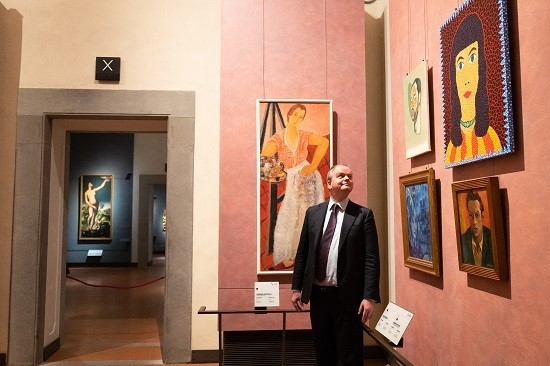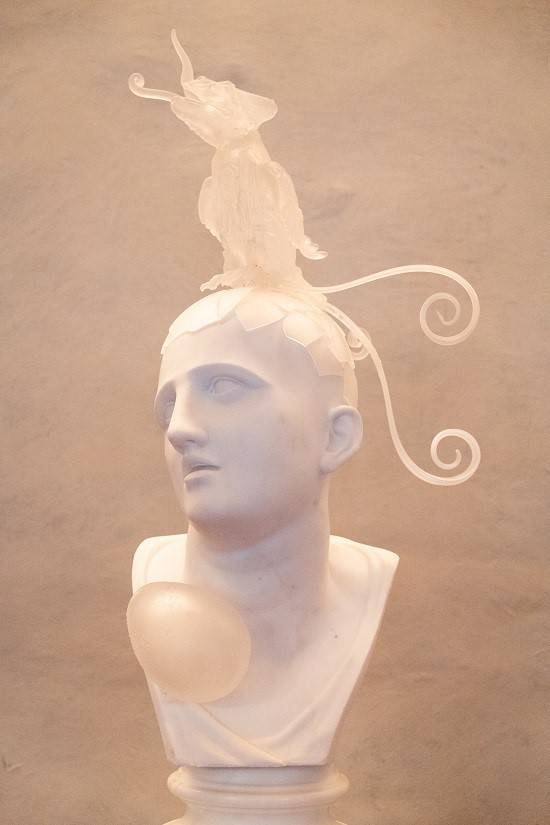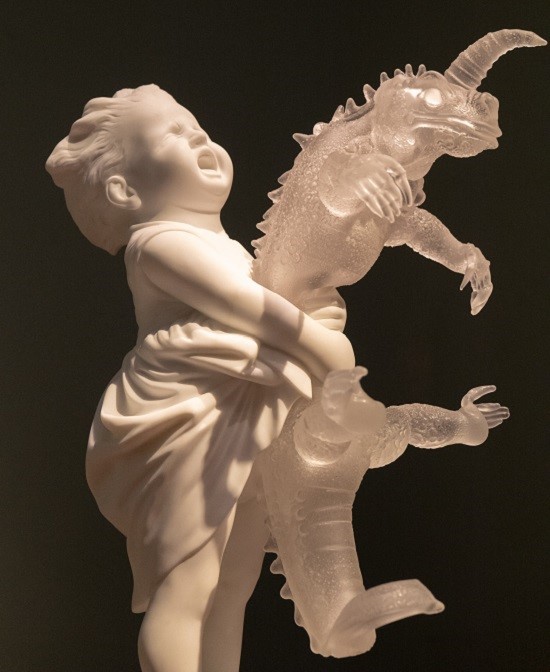FLORENCE, Italy — Walking past the Botticellis, Raphaels, and
Michelangelos at the
Uffizi Gallery, one could understandably be surprised to
come upon self-portraits by Ethiopian artist Tesfaye Urgessa and Japanese
artist Yayoi Kusama.
اضافة اعلان
At a time when
museums all over the world have been examining how to tell a more inclusive
story about art, the Uffizi has been slower to catch up, hamstrung by its
legacy as one of
Europe’s leading classical museums and by tourists expecting
to see history’s greatest hits.
But since
becoming director in 2015, Eike Schmidt has slowly been trying to integrate
more contemporary art, to increase the presence of female artists and artists
of color and to reach a younger, more diverse audience.
“The Uffizi very
rarely in the past had contemporary art exhibitions,” Schmidt said in a recent
interview at the museum. “It was seen as intruding on these sacred halls.”
 Eike Schmidt, the Uffizi Gallery director, stands with works by, clockwise from left: Adriana Pincherle, Tesfaye Urgessa, Yayoi Kusama, Renato Guttuso and Marc Chagall, at the museum in Florence, Italy, on January 28, 2022. (Photo: NYTimes)
Eike Schmidt, the Uffizi Gallery director, stands with works by, clockwise from left: Adriana Pincherle, Tesfaye Urgessa, Yayoi Kusama, Renato Guttuso and Marc Chagall, at the museum in Florence, Italy, on January 28, 2022. (Photo: NYTimes)
“For me, it has
been very important to get the dust off,” he added, “and to show what is
relevant.”
Other Florence
museums are engaged in similar efforts to broaden their reach, in part by
juxtaposing the old with the new and by looking at historical artworks through
a modern lens to foster dialogue between genres and eras. The
Palazzo Strozzi just closed a Jeff Koons exhibition and the Museo Novecento, dedicated to newer
works, is currently showing British painter Jenny Saville.
Changing the
public’s perception of art in Florence hasn’t been easy, said Arturo Galansino,
director of the Palazzo Strozzi. “Most people prefer to see contemporary art,”
he said, “In Italy, it was the other way around. People felt more comfortable
with the past than with the present.”
This began to
change in 2015, Galansino said, when Koons’ gilded steel sculpture “Pluto and
Proserpina” was installed smack dab in the center of the Palazzo Vecchio,
Florence’s medieval town hall, standing between copies of masterpieces by
Donatello and Michelangelo as part of the Florence International Biennale
Antiques Fair. “It was a symbolic moment,” Galansino said.
Koons said he has
felt welcomed by Florentines and that he considered the city an ideal location,
“where you’re embedded in the Renaissance, but you can also have a dialogue
with contemporary art.”
“That’s what art
does,” he added. “It makes connections from our own situations to others and
shows how everything is interwoven.”
In upending
traditional expectations of how classical art is presented, the Uffizi has also
joined museums such as the Metropolitan Museum of Art and The Frick Collection
in
New York City, both of which have rethought the exhibition of old masters in
the context of the Brutalist Breuer building on Madison Avenue in Manhattan.
“Every living
artist would love to engage with the Uffizi,” said Max Hollein, director of the
Met. “It’s a paradise.”
 “Temptation (Niobe)” by Koen Vanmechelen, at a solo show by the Belgian artist at the Uffizi Gallery in Florence, Italy, on January 28, 2022. (Photo: NYTimes)
“Temptation (Niobe)” by Koen Vanmechelen, at a solo show by the Belgian artist at the Uffizi Gallery in Florence, Italy, on January 28, 2022. (Photo: NYTimes)
The Uffizi
recently opened an exhibition by one of those living artists,
Koen Vanmechelen,
a multidisciplinary Belgian artist who focuses on the relationship between
nature and culture. The show, “Seduzione,” which runs until March 20, features
30 artworks including huge horned iguanas, a crouching red tiger and a
re-imagined Medusa topped by open beaks and sharp teeth, all of which were
created expressly for the hallowed halls of the Uffizi.
The museum has
also recently featured shows by living artists such as British sculptor
Antony Gormley, arte povera figure
Giuseppe Penone and Urgessa, whose work focuses on
social criticism, race and the politics of identity.
Although he felt
out of place at the Uffizi at first — particularly given the art’s preponderance
of biblical content — Urgessa said in a telephone interview that he was
welcomed by visitors there and that the institution seemed to be changing from
“something from the past, like the pyramids.”
“Nowadays people
want to hear about a new story,” he added, “a story related to their lives.”
Schmidt said he
is committed to dedicating at least two exhibitions a year to female artists.
Last February, for example, the Uffizi presented “Lo Sfregio” (“The Scar”), a
show that took a stand opposing violence against women by presenting Gian
Lorenzo Bernini’s bust of disfigured Costanza Piccolomini Bonarelli alongside
Ilaria Sagaria’s photographic exhibition “Pain is not a privilege,” which
portrays the victims of acid attacks.
 “Cosmopolitan Fossil II” by Koen Vanmechelen, at a solo show by the Belgian artist at the Uffizi Gallery in Florence, Italy, on January 28, 2022. (Photo: NYTimes)
“Cosmopolitan Fossil II” by Koen Vanmechelen, at a solo show by the Belgian artist at the Uffizi Gallery in Florence, Italy, on January 28, 2022. (Photo: NYTimes)
With exhibitions,
the Uffizi is also trying to push past the confines of its white, male,
Eurocentric history. With “On Being Present” in 2020, the museum explored black
identity in paintings, such as the wise man in Dürer’s “Adoration of the Magi”
and the portraits of Ethiopian kings in its Giovio Series. The same year, the
Uffizi presented an exhibition on women, power and emancipation in ancient
Rome.
Despite not
getting a website until 2015 — Schmidt has said the museum was “in the Stone
Age” — the Uffizi has become an unlikely social media phenomenon, with nearly
700,000 followers on Instagram; more than 100,000 on TikTok and nearly 128,000
on Facebook.
It also recently
launched a YouTube cooking show called “Uffizi da Mangiare” (“Uffizi on the
Plate”) that features chefs making meals inspired by works in the collection.
Schmidt said he
is seeing results; visitors between the ages of 19 and 25 “more than doubled”
in the year leading up to 2020, he said.
Similarly,
Galansino said that by showing contemporary artists — such as Ai Weiwei and,
next fall, Olafur Eliasson — his museum has attracted a new audience, more than
30 percent of whom are younger than 30.
Given such
efforts by museums such as the Strozzi and the Uffizi, as well as Florence’s
convenient location between the cosmopolitan hubs of Rome and Milan, Galansino
said he is convinced that Florence can become “a contemporary art city.”
“I think we’ve convinced
the public that contemporary art is as important as old masters,” he said.
“People lost the perception of Florence as a living place, but it is still a
living place. It’s not just living in the past.”
Read more Culture and Arts



